Animal-like Protists Who Are Heterotrophic Are Classified as
Animal-like Protists Who Are Heterotrophic Are Classified as
What is Protista?
Protista is a single organism and information technology becomes a protist when information technology converts into a group. A protist is a kingdom or group of different members having a unicellular or unmarried-cell construction similar to protozoa, fungi, and algae. Ernst Haeckel, a German zoologist, gave the term Protista in 1866.
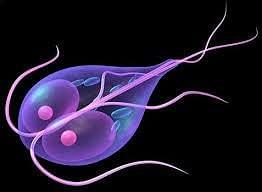
Protists are aquatic organisms that incorporate eukaryotic protists which are non true animals, plants, or fungi. Some protists do not accept a multicellular phase. In some of these organisms, motion is accomplished past using appendages, such as cilia or flagella.
Characteristics of Protista
- The members of protists are various and have very few common features.
- Protists are the organisms that are non classified as a plant, animals, mucus, or bacteria( prokaryotes ).
- Eukaryotic protists accept a nucleus and are uncomplicated in construction.
- There are more than similarities than differences between members of the Protista kingdom, which tin can be judged from how they differ from members of other kingdoms.
- Information technology does not have a stock-still shape. Protists are having unlike shapes.
- Protists are food-contained. They make their own nutrient through chloroplast or they eat other organisms or their parts and products, they also eat the remains of other organisms.
- Protista is the basis of the aquatic nutrient chain and produces massive amounts of oxygen.
- It reproduces either sexually-that is through conjugation and asexually through binary fission or multiple fission.
Likewise Read:
Nomenclature of Protista
Given below is the classification of the kingdoms nether which protista is listed under unicellular organisms which is a office of eukaryotes.

Then the Protista has the following sub-parts:
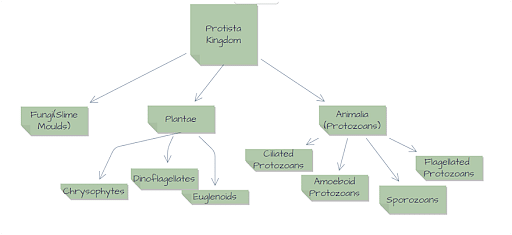
-
Fungi Protista(Slime Moulds)
Fungi Protista is a heterotrophic eukaryotic organism and is also called saprotrophs when using decomposable material as food. It becomes a parasite when it requires a host organism's living protoplasm of a host organism for food. Chitin has cell walls made of tough complex sugar and has the capacity to become multicellular organisms at some stages in its life.
Blue Green algae (as well known as blue-green alga) are sometimes mutually dependent on sure fungal species. Such relationships are termed symbiotic relationships. These symbiotic life forms are chosen lichens. It is common knowledge that lichens are the big colored patches that slowly grow on tree bark.
Examples are Fuligo septica, Physarum, Dictyostelium, and Polysphondylium.
-
Plantae Protista
Plantae Protista is autotrophs and just like the leaves, the protist uses chlorophyll to brand photosynthesis. It has cell walls and has multicellular eukaryotes. All the plants are a office of this Protista and are divided into three types:
- Dinoflagellates: Dinoflagellates are equanimous of ii words dinos and flagellum, where dinos mean whirling and flagellum mean whip scourge. These are marine organisms and are also common in freshwater habitats which incorporate pigments of different colors similar light-green, yellow, brown, crimson, or blue.
Dinoflagellates form of import components of phytoplankton.
Bioluminescence is a phenomenon of dinoflagellates that emit light and glow in the nighttime.
Examples are Gonyaulax, Noctiluca, and etc.
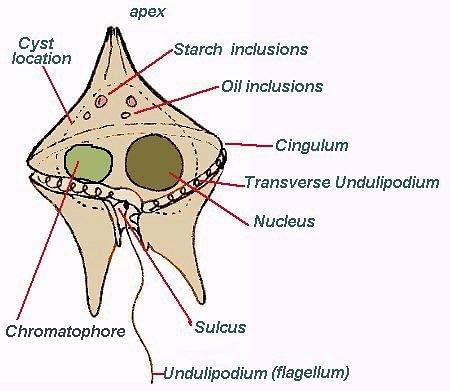
Dinoflagellate
- Chrysophytes: Chrysophytes mean aureate plants. It is a unicellular plant-like protist that contains chlorophyll, carotene, and xanthophylls. This type of protist has a rigid cell wall that is made of pectin or cellulose or silica. It reproduces asexually and sexually and stores nutrient like oil, not starch-like plants. Chrysophytes appear in the form of yellow and dark-green algae.
Examples are Diatoms, Desmids.
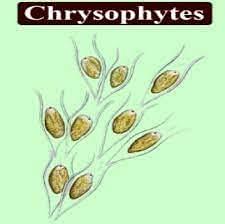
- Euglenoids: Euglenoids have characteristics of both plants and animals which have no cell wall. Information technology has a flexible trunk due to a protein-rich layer which is chosen a pellicle. In euglenoids, 2 flagella and chlorophyll are present that have a red eyespot that responds to the light. It is a unicellular protist that reserves food in paramylon in the cytoplasm. Euglenoids' habitats are marine and freshwater similar puddles, ditches, ponds, streams, lakes, and rivers and have a mesokaryotic nucleus.
Case: Euglena, Phacus.
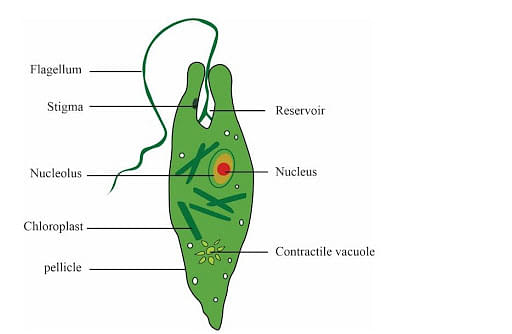
Euglenoids
-
Animalia Protists(Protozoans)
Animalia protists are heterotrophs and are multicellular eukaryotic organisms that do not have prison cell walls. It is divided into iv groups:
- Amoeboid Protozoans: Amoeboid Protozoa are unicellular protozoans that move and feed by cytoplasmic projections which are termed every bit pseudopodia or simulated feet. These are characterized by the form and construction of their pseudopods. Information technology is common in soils and aquatic habits and its food is captured by phagocytosis.
Amoeboid protozoans have body types that range from free-flowing to rigid with skeletal supports. Information technology reproduces asexually through binary fission.
Examples are Rhizopodans, Entamoeba.
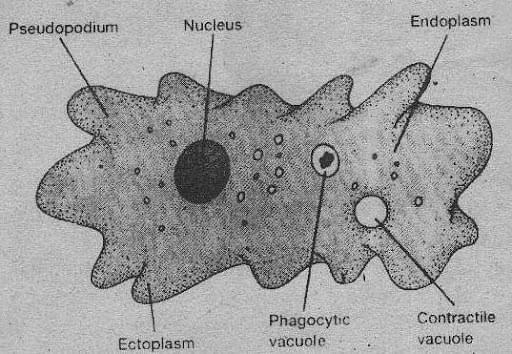
Amoeboid Protozoans
- Flagellated Protozoans: These are simple, single-celled animals that are over 50,000 recognized species. Flagellated Protozoans are very small-scale and have an elongated body and a leaf-like advent with upward to 975000/mL of blood.
A flagellated organism is defined past the presence of 1 or more flagella and a definite torso shape. Its most species are free-living and mobile.

Flagellated Protozoans
- Ciliated Protozoans: Ciliated Protozoa are a protozoan that moves using cilia. It ingests food through an oral groove covered by cilia. This blazon of protozoa, reproduction is by binary fission or conjugation.
Example: Paramecium.
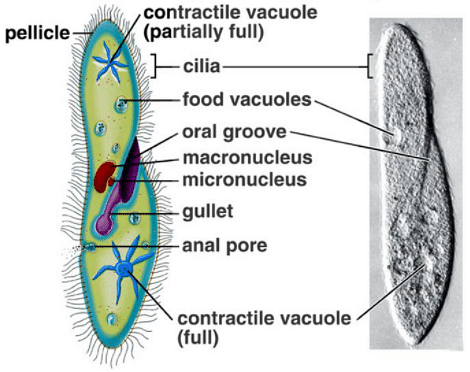
Ciliated Protozoans
- Sporozoans: These are animal-like protists that accept role of their life cycle inside the cells of their hosts. Mosquitoes are part of the life cycle of sporozoans. They suck claret from the infected humans, ingesting the sporozoans. It undergoes sexual reproduction in the musquito'southward gul.
It is more often than not plant in mosquitoes. When a musquito bites a person, the protozoans infect the blood and liver of the host. In the red claret cells, parasites reproduce asexually, destroying them equally they go out.
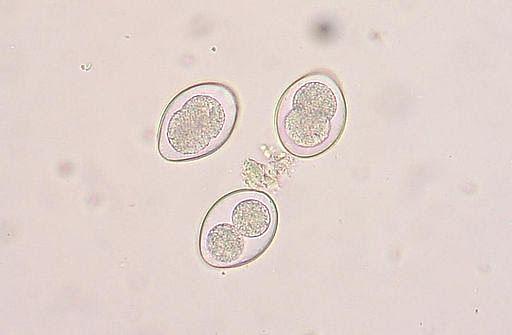
Sporozoa
All in all, Protista is a kingdom or a group of organisms whose nearly members are single-celled organisms like algae, fungi, bacteria, and protozoa. Protists provide food to animals and it is also helpful in producing oxygen and tin also exist used to produce biofuel.
Besides Read:
Importance of Protista
Given beneath are the diverse types of importance of protista such as ecological, economic and revolutionary.
Ecological Importance of Protists
- Autotrophic protists are a primary component of phytoplankton.
- These organisms bear out 70-80% of the world's photosynthesis.
- Phytoplankton and Zooplankton(heterotrophic protists) are the base of most of the world's nutrient chain.
- It is also used for medical inquiry. That is a medicine made from protists used to treat loftier blood force per unit area, ulcer, arthritis, and digestion problems.
Economic Importance of Protists
- Protists are used every bit soil fertility or biofertilizers:
- These are gratuitous-living fixing bacteria.
- Symbiotic nitrogen-fixing bacteria
- Ammonifying bacteria is helpful in:
- Antibody product, like bacitracin - B. Licheniformis; Subtilin - B. subtilis
- Retting of fibers
- Curing of leaves like tea leaves Micrococcus candidans
- Too used in vinegar production similar acetobacter aceti.
Evolutionary Importance of Protists
- Protists are considered to be the ancestors of three multicellular kingdoms i.e., fungi, plants, and animals.
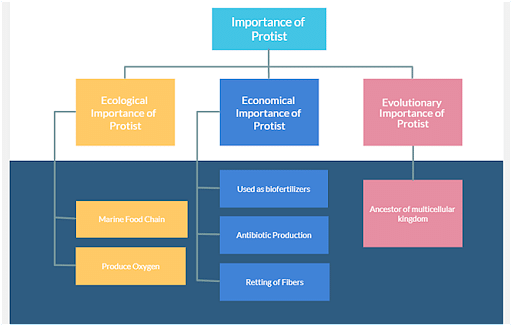
Things to Remember
- Unicellular eukaryotic organisms, protozoa are characterized by their whip-similar flagella and hair-similar cilia that are used to move effectually.
- These are institute in all types of atmosphere and can be autotrophic or heterotrophic.
- Protista is of iii types Plantae, fungi , and Animalia Protista which are further divided into different Protista.
- Protists are important equally it produces oxygen on the planet through photosynthesis and they are plant-similar protists. Some protists decompose and recycle nutrients that humans need to live.
- Protists are used to brand medicines used to treat high blood pressure level, ulcers, arthritis, and digestion problems.
Also Read:
Sample Questions
Ques. What is Protista? (2 marks)
Ans. Protista is a single-celled organism that has a simplified cellular construction and has whip-similar flagella and hair-like cilia to move effectually. Protista tin exist autotrophic and heterotrophic.
Ques. What are Eukaryotic Organisms? (3 marks)
Ans. Eukaryotic organisms are organisms or cells that have a nucleus that is surrounded by a nuclear membrane inside the cells.
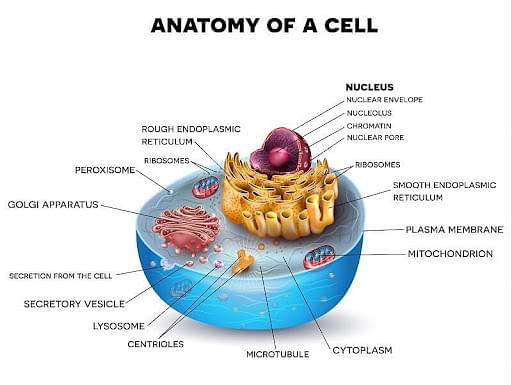
Eukaryotic Jail cell
Ques. What is Phytoplankton? (2 marks)
Ans. Phytoplankton are microscopic plants that live in the upper part of the ocean where light penetrates. Information technology needs sunlight for photosynthesis only like any other institute. An of import thing about phytoplankton is that it provides food for many animals.
Ques. What is Cilia? (3 marks)
Ans. This is a small hair-like structure on the outside of the organelles of almost all mammal cells. Information technology is found in eukaryotic cells and is rare every bit found in plants. Information technology is found on the plasma membrane of certain cells of multicellular or unicellular organisms that assist locomotion.
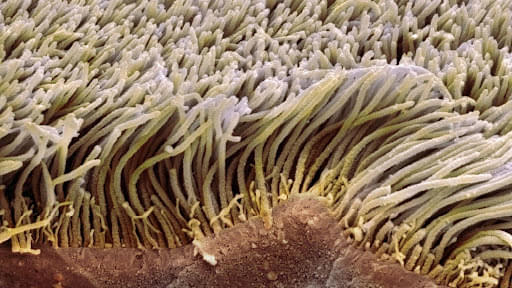
Cilia
Ques. What are the features of Protista? (5 marks)
Ans. The feature of Protista are:
- They are eukaryotic organisms
- Protista can be unicellular or multicellular
- They are autotrophs or heterotrophs
- They can reproduce sexually or asexually
- They prefer to alive in aquatic or moist environments.
Ques. 6 What are Unicellular Organisms? (1 mark)
Ans. Unicellular organisms are organisms that have merely one jail cell and perform all the important functions. It includes organisms similar yeasts, bacteria, and protozoa.
Ques. Difference between sexual and asexual reproduction? (3 marks)
Ans. The differences are:
| Sexual Reproduction | Asexual Reproduction |
|---|---|
| It involves 1 or 2 organisms. | Information technology involves single organisms. |
| Information technology occurs due to pollination and fertilization. | It occurs by budding, fragmentation, and sporulation. |
| It is highly useful for natural selection in the evolution of species. | It is not very useful for natural selection in the evolution of species. |
Animal-like Protists Who Are Heterotrophic Are Classified as
Source: https://collegedunia.com/exams/protista-meaning-characteristics-and-classification-biology-articleid-2675

Komentar
Posting Komentar